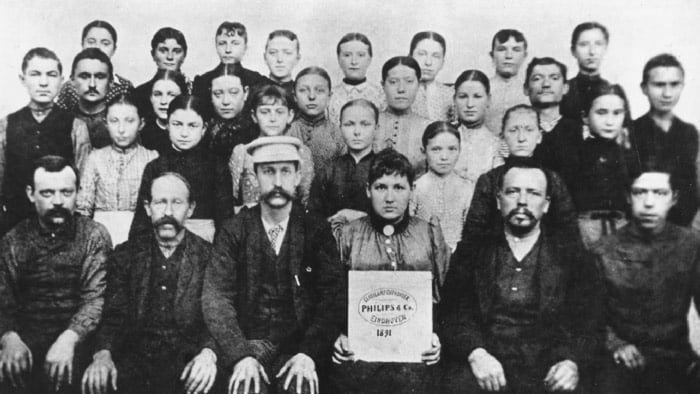When looking at the evolution of modern technology, Philips emerges as a leader in both innovation and resilience. With more than a century of history, the company has continually adapted to changing times, leaving a lasting impact on the way we use and interact with technology.
Humble Beginnings and Steady Growth
Philips was founded in 1891 by Gerard Philips and his father Frederik in Eindhoven, Netherlands. Their first product? Carbon-filament lamps. This modest start laid the groundwork for what would become a global force in electronics. Despite facing financial struggles and fierce competition, their dedication to quality and improvement enabled them to push forward, setting the stage for a brighter future. This same commitment to innovation is evident in their line of coffee machines, such as the Philips 5500 LatteGo Review, Philips 5400 LatteGo Review, and the comparison of the Philips LatteGo 5400 vs 4300.
Early Expansion and Innovation
By the early 1900s, Philips had become one of Europe’s premier light bulb manufacturers. But their vision extended far beyond lighting. In 1914, they established the Philips Research Laboratory (NatLab), which would fuel the company’s innovative drive for decades to come.
In the 1920s and 1930s, Philips took a bold step into the radio market, recognizing the medium’s growing potential. By 1932, they had sold over a million radios, proving their knack for understanding and predicting consumer needs.
World War II: A Test of Resilience
The outbreak of World War II brought immense challenges for Philips. While their operations were disrupted, the company’s resilience shone through. Key personnel were relocated, and despite the war, Philips continued secret research and contributed to the development of radar technology, demonstrating their ability to thrive in adversity.
Post-War Breakthroughs
After the war, Philips entered a period of rapid innovation. One of their most significant contributions came in 1963 with the launch of the compact audio cassette, revolutionizing how people recorded and listened to music. This simple invention became a global standard and shaped music consumption for years.
Philips' collaborative spirit was also evident in the 1970s when they teamed up with Sony to develop the compact disc (CD). This partnership not only changed the music industry by bringing digital audio to the masses but also showcased Philips’ leadership in technological advancement.
Diversification and Technological Prowess
As the 20th century progressed, Philips diversified its offerings. From consumer electronics to home entertainment, their innovations left a lasting mark. They were instrumental in the development of VHS tapes and DVDs, technologies that defined home entertainment for generations.

Early Expansion and Innovation
By the early 1900s, Philips had become one of Europe’s premier light bulb manufacturers. But their vision extended far beyond lighting. In 1914, they established the Philips Research Laboratory (NatLab), which would fuel the company’s innovative drive for decades to come. This forward-thinking approach mirrors the innovations in their coffee machines today, such as the Philips 3200 vs 4300 vs 5400, which showcase how the brand continues to push boundaries. For example, the Philips 3200 vs 4300 and Philips 3200 vs 5400 comparisons highlight the technological advancements and user-focused features that Philips has embraced in its products.
In the 1920s and 1930s, Philips took a bold step into the radio market, recognizing the medium’s growing potential. By 1932, they had sold over a million radios, proving their knack for understanding and predicting consumer needs.
World War II: A Test of Resilience
The outbreak of World War II brought immense challenges for Philips. While their operations were disrupted, the company’s resilience shone through. Key personnel were relocated, and despite the war, Philips continued secret research and contributed to the development of radar technology, demonstrating their ability to thrive in adversity.
Post-War Breakthroughs
After the war, Philips entered a period of rapid innovation. One of their most significant contributions came in 1963 with the launch of the compact audio cassette, revolutionizing how people recorded and listened to music. This simple invention became a global standard and shaped music consumption for years.
Philips' collaborative spirit was also evident in the 1970s when they teamed up with Sony to develop the compact disc (CD). This partnership not only changed the music industry by bringing digital audio to the masses but also showcased Philips’ leadership in technological advancement.
Diversification and Technological Prowess
As the 20th century progressed, Philips diversified its offerings. From consumer electronics to home entertainment, their innovations left a lasting mark. They were instrumental in the development of VHS tapes and DVDs, technologies that defined home entertainment for generations.
In the 1990s, Philips introduced Ambilight TVs, which enhanced the viewing experience by projecting light that synchronized with on-screen content. This continued their trend of blending cutting-edge technology with consumer needs.
The Shift Toward Healthcare
Philips saw the future of technology extending beyond entertainment and electronics. In the 1980s, they made a strategic investment in healthcare technology, acquiring companies that specialized in medical imaging and patient monitoring. This pivot positioned Philips as a leader in the healthcare industry, a focus that remains central to their business today.
Focusing on Health and Lighting Solutions
In recent years, Philips has undergone a significant transformation, shifting away from traditional consumer electronics to focus on health technology and lighting solutions. In 2016, they spun off Philips Lighting as a separate company, now known as Signify, allowing Royal Philips to concentrate on healthcare innovations, particularly connected healthcare solutions and medical technology.
Leading the Charge in Sustainability
Philips is committed to sustainability and corporate responsibility. They’ve set ambitious goals to reduce their environmental footprint and aim to become carbon-neutral in their operations. Their embrace of circular economy principles further highlights their dedication to sustainable business practices.
Additionally, Philips has integrated artificial intelligence and data analytics into their products and services, pushing forward into the digital age with a focus on connected healthcare solutions that enhance patient care.

Conclusion
Philips' history is a testament to innovation, resilience, and adaptability. From a small operation making light bulbs to a global leader in health technology, the company has continuously evolved while staying true to its mission of improving lives through meaningful innovation. Their journey through the ever-changing landscape of technology suggests that Philips will continue to shape the future, carrying forward the pioneering spirit that has defined them for over a century. This innovation is also evident in their coffee machines, with products like the Philips LatteGo 5400 Review, Philips 3200 LatteGo Review, and Philips 4300 LatteGo Review showcasing their commitment to quality and cutting-edge design.
